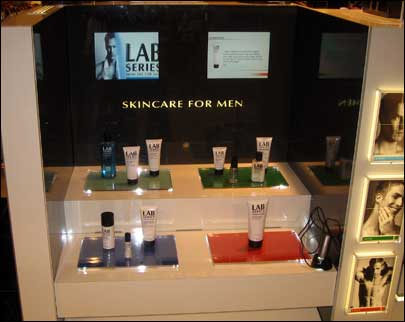When shoppers at five stores in the United Kingdom and North America browse through Estée Lauder‘s Lab Series Skincare for Men products, the kiosk on which those items are displayed interacts with them. By lifting a product off the shelf, consumers can activate and watch a video regarding that product that ceases playing when they return it to its proper place. This is part of an RFID-based system created by Lime IT & Media Solutions Ltd., an IT systems integrator and RFID hardware reseller, and Remote Media, a British company that markets a hosted digital signage system known as Signagelive. Not only does the technology provide video displays for customers, it also allows Estée Lauder to track the effectiveness of its displays, by storing data on the Signagelive server detailing how frequently tagged products were taken off the shelf, compared against the store’s point-of-sale data.
The system—installed in the first store in October 2008, and now deployed in five locations—is the result of Estée Lauder’s efforts to add some excitement to the shopping process, the company indicates. Estée Lauder sought an interactive system that would require as little intervention as possible, enabling consumers to learn more about the products being offered without having to make any effort to obtain that information.

The resulting system is installed in four House of Fraser stores in the United Kingdom—two located in London (Oxford Street and White City), and one each in Bristol and Belfast. The system has also been set up at Holt Renfrew, located in Toronto. If the system yields a positive return on investment (ROI), Estée Lauder hopes to expand it to additional stores in Europe and North America, according to Lime IT and Remote Media. Estée Lauder did not respond to requests for comment.
“The whole of this system is based around providing a solution that uses RFID as a mechanism to deliver the content to the end user,” says Dominic Lennon, Lime IT’s director. “The users do not have to press anything, scan anything or touch anything to get the content delivered to them; the user has only to pick up a product—a very natural human action.”
The solution comprises a kiosk with RFID interrogators built into its product display shelves, as well as two 12-inch LCD screens in each of the British installations, and one 46-inch screen in Toronto. Adhered to the bottom of each Lab Series product is a passive 13.56 MHz Texas Instruments Tag-it tag, compliant with the ISO 15693 standard. When products are sitting on the shelves, the RFID interrogators continually capture each tag’s unique ID number. When a customer picks up an item from the display, the interrogators can no longer read its tag, prompting the Signagelive software to play a video, specific to the selected product, on the LCD screen. In the first two days of launching the system at the first store in October, Lime IT reports, 800 customer interactions were recorded.
Additionally, each time a product is removed from and returned to a shelf, that action is also transmitted via the Internet to the Signagelive server, which stores and analyzes the data. Estée Lauder can log onto a password-protected Signagelive Web site and view the number of transactions at the kiosk, then compare that information with sales transactions that took place on the same day and at the same store in which the kiosk is located. Estée Lauder and other Signagelive clients receive a year’s worth of free service with the initial purchase of the kiosk and RFID hardware. After that initial year ends, the manufacturer will be charged a monthly fee for accessing that data.
In addition to displaying product videos, the system offers other features as well. Sales employees, known as consultants, can place a “Skin Consultant” tag on one of the shelves. When an interrogator reads the tag’s unique ID number, it activates a camera that photographs a customer’s skin. A magnified image of that person’s skin is then displayed on one of the LCD screens, enabling the consultant to analyze the skin type and recommend products based on the results of that analysis. There is also a “Supervisor” tag that store consultants can use by placing it near a kiosk RFID reader, which instructs the system to go into maintenance mode. The consultant can then add a new product to the system, and have a video about that item available for playback when selected.
Remote Media was formed in the mid 1990s as a provider of digital signage and interactive touch-screen systems for ATM machines and other financial services. In the past few years, says Jason Cremins, Remote Media’s CEO, the company has been introducing radio frequency identification into its products. “The traditional way to provide media is the touch screen,” Cremins says. “That takes a leap of faith to ask the customer to interact with the screen. By using RFID, it becomes incredibly intuitive.”
Lennon declines to specify the price for the system in this application, or the cost in general, saying it varies considerably depending on the solution. “We appreciate it’s not cheap,” Cremins states. “It’s going to be higher-end goods providers who will be attracted to the system to justify that cost.”
Cremins expects services such as this to become more common as they are further piloted to prove their value, as well as being fueled by the continued price reduction of RFID tags and readers. An unnamed U.K. retailer is also testing the system, whereby a customer picks up a tagged DVD from a shelf, and the LCD displays a video about that specific title. That pilot, underway in two of the retailer’s stores, was launched in December 2008.


